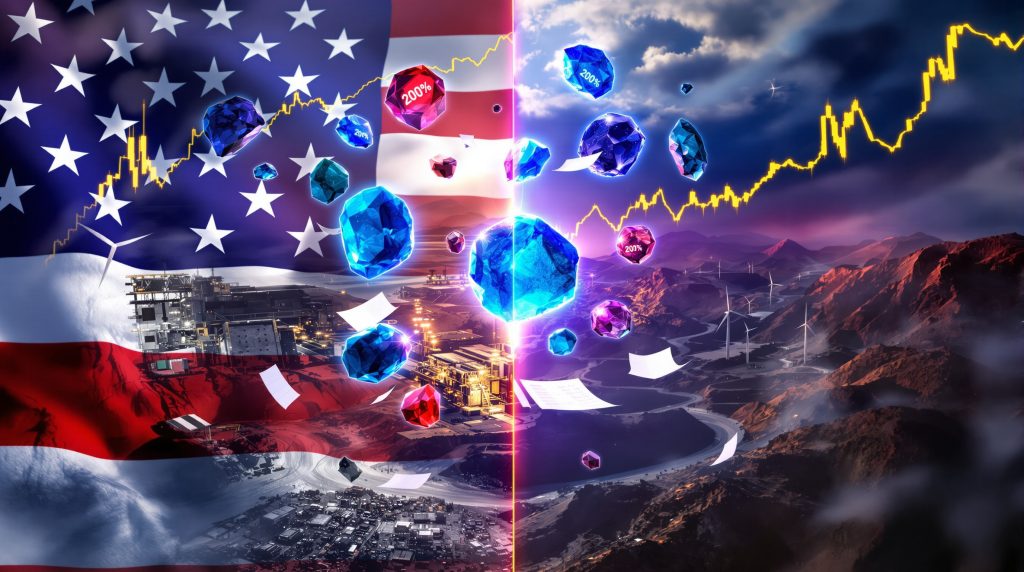The Strategic Value of Rare Earth Elements in US-China Relations
Rare earth elements represent far more than obscure entries on the periodic table—they form the backbone of modern technology and have become pivotal chess pieces in the geopolitical rivalry between the United States and China. These 17 elements, despite their misleading name, aren't particularly rare in the Earth's crust, but economically viable concentrations are scarce and processing capabilities even more so.
Modern smartphones, electric vehicles, wind turbines, and advanced defense systems all depend on these minerals for their functionality. Without neodymium and dysprosium, powerful permanent magnets that drive electric motors would be impossible. Without europium and terbium, our displays wouldn't produce vibrant colors. And without lanthanum and cerium, many catalytic converters and polishing compounds would cease to exist.
The global rare earth permanent magnets market has surged to nearly $20 billion annually, underscoring their critical importance to the world economy. What makes these elements particularly significant in international relations is their concentrated supply chain—China controls approximately 60% of global rare earth extraction and 85-90% of processing capacity, according to the latest U.S. Geological Survey data.
Applications Driving Strategic Importance
The defense sector represents one of the most critical applications for rare earth elements. Precision-guided munitions require rare earth magnets for their steering mechanisms. Night vision systems depend on rare earth phosphors. Communications equipment, radar systems, and electronic warfare capabilities all incorporate these materials in ways that cannot be easily substituted.
Beyond defense, renewable energy technologies rely heavily on rare earths. A typical direct-drive wind turbine contains approximately 600 kg of rare earth materials in its permanent magnets. Electric vehicle motors typically require 1-2 kg of neodymium and smaller amounts of dysprosium or terbium depending on performance requirements.
Consumer electronics constitute another major application, with smartphones containing small but critical amounts of up to eight different rare earth elements. Medical imaging equipment, particularly MRI machines, require significant quantities of rare earths for their superconducting magnets.
China's Dominant Market Position
China's stranglehold on the rare earth supply chain didn't happen by accident. Beginning in the 1980s, Beijing recognized the strategic value of these elements and initiated systematic development of its resources. Through decades of investment in mining, processing, and manufacturing capabilities, coupled with less stringent environmental regulations than Western competitors, China achieved dominance across the entire value chain.
Today, China not only mines approximately 60% of the world's rare earth raw materials but processes 85-90% of oxides and manufactures more than 90% of the high-performance magnets containing these elements. The country's state-owned enterprises have vertically integrated operations from mining through manufacturing, creating significant barriers to entry for potential competitors.
The Mountain Pass mine in California, operated by MP Materials, represents America's only active rare earth mining operation. While it produces a significant amount of rare earth concentrate, most of this material still requires processing in China—highlighting the depth of U.S. dependency on Chinese processing capacity.
Strategic Control Mechanisms
China has demonstrated its willingness to leverage its rare earth dominance for geopolitical advantage. In 2010, during a territorial dispute with Japan, China reportedly restricted rare earth exports, causing prices to spike dramatically. Though China denied implementing an official embargo, the incident served as a wake-up call to rare earth-dependent nations.
Beijing maintains several mechanisms for controlling its rare earth industry, including:
- Production quotas assigned to state-approved mining companies
- Export licensing requirements that can be adjusted based on diplomatic considerations
- Environmental inspections that can selectively target or exempt facilities
- Strategic stockpiling programs to influence market prices
- Consolidation of mining operations under larger state-influenced entities
These tools provide China with significant flexibility to respond to trade tensions by either restricting supply or flooding markets to undercut emerging competitors.
The Specter of Tariff Escalation
Trade tensions between the U.S. and China have frequently centered on rare earth elements, with both sides recognizing their strategic value. Past U.S. administrations have expressed concern about dependency on Chinese rare earth supplies, particularly for defense applications.
Threats of substantial tariffs on Chinese goods if rare earth supplies are restricted would represent a significant escalation in US-China trade impacts. Such measures could potentially increase costs for U.S. manufacturers dependent on these materials while potentially triggering retaliatory measures from Beijing in other sectors.
Market analysts suggest that major disruptions to the rare earth supply chain could lead to price increases of 30-45% for consumer electronics and similar increases for other high-tech products. The ripple effects would impact global supply chains for electric vehicles, wind turbines, and various defense systems.
Economic Implications of Supply Disruptions
Any substantial disruption to rare earth supplies would create cascading effects throughout manufacturing sectors:
- Electric vehicle production could face significant delays and cost increases
- Consumer electronics manufacturers might need to redesign products or pass costs to consumers
- Wind turbine manufacturers would face higher input costs, potentially slowing renewable energy deployment
- Defense contractors could struggle to meet production schedules for advanced systems
Historical precedent suggests rare earth price volatility can be extreme. During previous supply disruptions, price increases of 300-600% occurred for certain elements, creating market uncertainty and triggering stockpiling behaviors that further exacerbated supply-demand imbalances.
The Critical Nature of Rare Earth Elements
What makes rare earth elements "critical minerals" extends beyond their economic value to their irreplaceability in many applications. The unique properties of these elements—particularly their magnetic, luminescent, and electrochemical characteristics—cannot be duplicated using other materials.
For high-performance permanent magnets, elements like neodymium, praseodymium, dysprosium, and terbium provide magnetic field strengths impossible to achieve with conventional materials. These magnets enable the miniaturization of electronics and the efficiency of electric motors that define modern technology.
Technical Applications and Material Properties
Rare earth elements possess unique properties that make them indispensable:
- Neodymium creates the strongest permanent magnets available, essential for compact electric motors
- Dysprosium allows magnets to maintain performance at high temperatures, critical for demanding applications
- Europium provides red phosphors for displays and lighting applications
- Cerium serves as a polishing compound for precision optical equipment
- Lanthanum functions as a catalyst in petroleum refining and in nickel-metal hydride batteries
The defense sector particularly depends on these properties. According to industry estimates, a significant percentage of rare earth magnets used in U.S. defense applications originate from China-dominated supply chains, creating national security vulnerabilities.
Supply Chain Vulnerabilities
Developing alternative supply chains faces multiple hurdles:
- Capital-intensive processing facilities require years to permit and construct
- Technical expertise in separation and purification remains concentrated in China
- Environmental challenges in processing create regulatory barriers in Western nations
- Economic viability requires scale that new entrants struggle to achieve
These factors create lead times of 18-24 months or longer to develop meaningful alternative supply chains, leaving importing nations vulnerable to supply disruptions in the interim.
China's Strategic Use of Rare Earth Dominance
China has historically employed various measures to maintain control over the rare earth market and leverage this position for diplomatic and economic advantage. Between 2010-2014, China implemented formal export quotas that restricted the flow of rare earth materials to international markets.
While these quotas were eventually ruled illegal by the World Trade Organization, China subsequently implemented a comprehensive resource tax and stricter environmental regulations that achieved similar supply-restricting effects while remaining WTO-compliant.
Strategic Industry Consolidation
China has systematically consolidated its rare earth industry over the past decade, reducing the number of licensed mining companies and directing them under larger state-influenced enterprises. This consolidation serves multiple purposes:
- Enhances central government control over production volumes
- Improves ability to enforce environmental regulations
- Creates economies of scale for processing operations
- Strengthens pricing power in international markets
- Facilitates coordination with broader industrial policies
The country has also integrated rare earth production with downstream manufacturing of high-value products like permanent magnets, creating a vertically integrated industrial ecosystem that captures more value from the supply chain.
U.S. Strategies to Reduce Rare Earth Dependency
Recognizing the strategic vulnerability created by rare earth dependency, the United States has implemented several initiatives to develop alternative supply chains. These efforts span domestic production, international partnerships, and technological innovation.
MP Materials' Mountain Pass mine in California represents the flagship domestic production initiative. The company has received substantial federal support to develop not only mining capacity but also processing capabilities that would reduce dependence on Chinese processing facilities.
Federal funding for domestic rare earth development has increased significantly, with over $3 billion allocated to various programs aimed at establishing complete supply chains within U.S. borders. These programs target a goal of supplying 25% of domestic rare earth needs from American sources by 2030. Furthermore, the former president's executive order on minerals has set the groundwork for strengthening domestic capabilities.
Technological Innovation Approaches
Beyond simply replicating China's existing supply chain, U.S. efforts include technological innovation to reduce dependency:
- Research into rare earth recycling technologies to recover materials from end-of-life products
- Development of magnet designs that use smaller quantities of critical elements
- Investigation of alternative materials that could replace rare earths in certain applications
- Advanced separation technologies that reduce environmental impacts of processing
Recycling shows particular promise, with new technologies potentially capable of recovering 60-70% of rare earths from end-of-life products by 2030, compared to current recovery rates of 35-40%. Recent rare earth breakthrough technologies have also shown promise in making extraction more efficient and environmentally friendly.
International Partnerships
Recognizing that domestic production alone cannot fully address supply chain vulnerabilities, the U.S. has pursued international partnerships with allies including Australia, Canada, and Japan.
Australia's Lynas Corporation has emerged as the most significant non-Chinese rare earth producer, with mining operations in Australia and processing facilities in Malaysia and Australia. The company has received U.S. government support to develop additional processing capacity specifically serving the American market. Additionally, Australia has established a critical minerals reserve to ensure supply chain resilience.
Japan, following its 2010 supply disruption experience, has invested heavily in rare earth recycling and alternative technologies while maintaining strategic reserves of critical materials—approaches that offer potential models for U.S. efforts.
Future Trajectories of Rare Earth Competition
The competition for rare earth supply chain control will likely intensify in coming years, with several potential scenarios for how US-China rare earth trade tensions might evolve.
Potential Escalation Paths
Escalation could take several forms:
- Targeted export restrictions on specific high-value elements rather than across-the-board limitations
- Gradual price increases implemented through production quotas and environmental regulations
- Technology transfer requirements imposed as conditions for continued material access
- Integration of rare earth policies with broader strategic competition in areas like semiconductor technology
Such measures could be implemented gradually to avoid triggering immediate and severe counteractions while still leveraging China's supply chain advantages, as China's rare earth export policies have demonstrated in the past.
Possible De-escalation Approaches
Despite tensions, several factors could drive de-escalation:
- Mutual recognition of the economic damage caused by supply chain disruptions
- Development of technical working groups focused on sustainable resource development
- Market-based mechanisms for price stability that benefit both producers and consumers
- Multilateral frameworks for resource security that include multiple producing and consuming nations
The deep integration of global supply chains creates mutual vulnerabilities that provide incentives for all parties to avoid extreme measures.
Economic Impacts of Supply Chain Disruptions
Various manufacturing sectors face different levels of vulnerability to rare earth supply disruptions based on their dependency profiles and ability to adapt.
Electric vehicle manufacturers face perhaps the most direct exposure, with rare earth permanent magnets essential to the high-efficiency motors that power most models. Industry analysts estimate that serious supply disruptions could increase production costs by 5-10% for standard EVs and potentially delay production as manufacturers scramble for alternative suppliers.
Wind turbine manufacturers similarly depend on rare earth magnets for their most efficient direct-drive designs. Each megawatt of capacity requires approximately 600kg of rare earth materials in these configurations, creating significant exposure to supply disruptions.
Price Volatility Patterns
Historical rare earth price volatility provides instructive lessons about potential market impacts:
- Previous supply disruptions triggered price increases of 300-600% for certain elements
- Secondary markets developed rapidly to trade materials at premium prices
- Stockpiling behavior by manufacturers amplified initial supply-demand imbalances
- Financial speculation in rare earth futures markets accelerated price movements
These patterns suggest that even relatively minor supply disruptions could trigger disproportionate market reactions due to the strategic nature of the materials.
Global Responses to Rare Earth Supply Challenges
Nations beyond the United States and China have recognized the strategic importance of rare earth elements and developed their own approaches to supply security.
Australia has positioned itself as a key alternative supplier through Lynas Corporation, which operates the Mount Weld mine producing significant quantities of light rare earth elements. The country has systematically developed its capabilities with government support and international partnerships.
Brazil has substantial rare earth reserves and has initiated development programs to capitalize on growing demand, though production remains at relatively early stages.
Japan, following its 2010 supply shock, implemented perhaps the most comprehensive rare earth strategy of any consuming nation. The country maintains strategic reserves covering approximately 5 years of critical element needs, has invested heavily in recycling technologies, and has formed international partnerships to secure diverse supply sources.
Strategic Stockpiling Approaches
Various nations have implemented strategic stockpiling programs with different characteristics:
- Japan maintains the most comprehensive reserves, covering multiple years of critical needs
- South Korea has established reserves focused specifically on elements for its electronics industry
- The European Union's Critical Raw Materials Act targets building both reserves and processing capacity
- The U.S. Defense Logistics Agency maintains modest stockpiles of specific materials for military needs
These programs reflect different assessments of vulnerability and strategic priorities among major consuming nations. The importance of these elements for the green transition materials supply chain has further emphasized their strategic value.
Understanding Rare Earth Elements: Practical Insights
What makes rare earth elements so important for modern technology?
Rare earth elements possess unique physical and chemical properties that enable critical functions in modern technologies. Their electron configurations create distinctive magnetic, luminescent, and electrochemical characteristics that cannot be replicated with other materials.
In permanent magnets, rare earths create field strengths orders of magnitude greater than conventional materials, enabling the miniaturization of electronics and efficiency of electric motors. Their luminescent properties produce specific wavelengths of light essential for displays and lighting applications. Electrochemical properties make them valuable as catalysts in various industrial processes.
Are rare earth elements actually rare in the Earth's crust?
Despite their name, most rare earth elements are relatively abundant in the Earth's crust. Cerium, one of the most commonly used rare earths, is approximately as abundant as copper. Even the least common rare earths are more abundant than gold or platinum.
The "rare" designation stems from their dispersed distribution and the challenges of finding economically viable concentrations. Additionally, rare earths typically occur together in deposits, requiring complex and costly separation processes to isolate individual elements for specific applications.
Why hasn't the U.S. developed its own rare earth supply chain despite known deposits?
The United States faces multiple barriers to rebuilding its once-dominant rare earth industry:
- Environmental regulations create higher compliance costs compared to operations in some competing nations
- Technical expertise in processing and separation has eroded as operations moved overseas
- Economic viability requires vertical integration and scale difficult for new entrants to achieve
- Capital costs for establishing processing facilities run into hundreds of millions of dollars
- Timeline from discovery to production typically spans 7-10 years for new mining projects
These factors create significant first-mover disadvantages that have deterred investment despite the strategic importance of these materials.
Could recycling solve the rare earth supply problem?
Recycling represents a promising but currently limited solution to rare earth supply challenges. Current technologies can only recover about 35-40% of rare earths from end-of-life products, though this percentage is gradually improving with research.
Several factors complicate recycling efforts:
- Rare earths are often used in small quantities dispersed throughout complex products
- Collection systems for end-of-life electronics remain inconsistent and incomplete
- Separation of individual elements from complex mixtures requires sophisticated processes
- Economic viability depends on relatively high rare earth prices to justify recovery costs
Despite these challenges, new urban mining technologies under development show promise for increasing recovery rates to 60-70% by 2030, potentially creating a significant secondary supply source.
The Future Landscape of Rare Earth Geopolitics
The rare earth element trade represents a microcosm of broader strategic competition, highlighting the tension between economic interdependence and national security concerns. As both major powers and smaller nations navigate this complex relationship, the global rare earth supply chain will likely undergo significant restructuring.
The fundamental reality remains that building alternative supply chains requires years of sustained investment, international cooperation, and technological innovation. Any transition away from the current concentrated supply structure will necessarily be gradual rather than abrupt.
For industries dependent on these critical minerals, developing supply chain resilience has become an essential business practice. Strategies include diversifying suppliers where possible, exploring material substitutions, engaging in strategic stockpiling, and investing in recycling technologies.
The table below illustrates the different applications and market dynamics of key rare earth elements:
| Rare Earth Element | Primary Applications | Global Production Share (China) | Price Volatility (2020-2024) |
|---|---|---|---|
| Neodymium | Permanent magnets, lasers | ~85% | High |
| Dysprosium | High-temperature magnets | ~90% | Very High |
| Terbium | Phosphors, fuel cells | ~90% | Extreme |
| Lanthanum | Catalysts, batteries | ~80% | Moderate |
| Cerium | Polishing, catalysts | ~80% | Low |
The continuing evolution of rare earth supply chains will fundamentally shape technological development, economic competitiveness, and strategic positioning in the coming decades. Nations and companies that successfully navigate these complex dynamics will gain significant advantages in both economic and security domains.
While technological innovation and market forces will play important roles in reshaping supply patterns, the strategic nature of these materials ensures that geopolitical considerations will remain central to their production, processing, and trade for the foreseeable future.
Want to Profit from the Next Major Mineral Discovery?
Discovery Alert's proprietary Discovery IQ model instantly notifies investors of significant ASX mineral discoveries, turning complex data into actionable insights for both short-term traders and long-term investors. Explore why historic discoveries can generate substantial returns by visiting Discovery Alert's dedicated discoveries page and begin your 30-day free trial today to position yourself ahead of the market.




